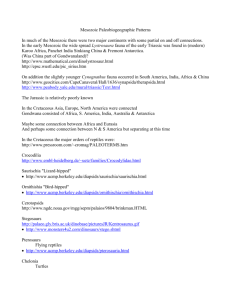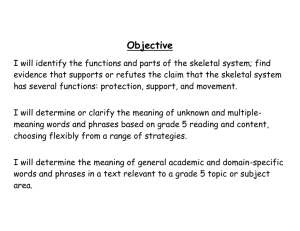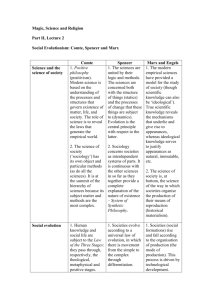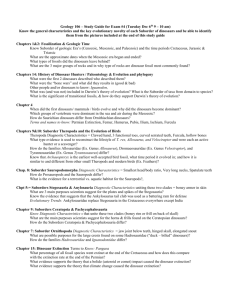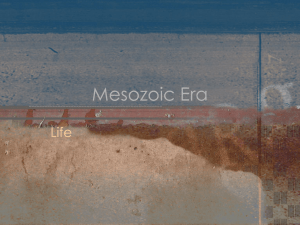Archosauria Phylogeny Powerpoint
advertisement
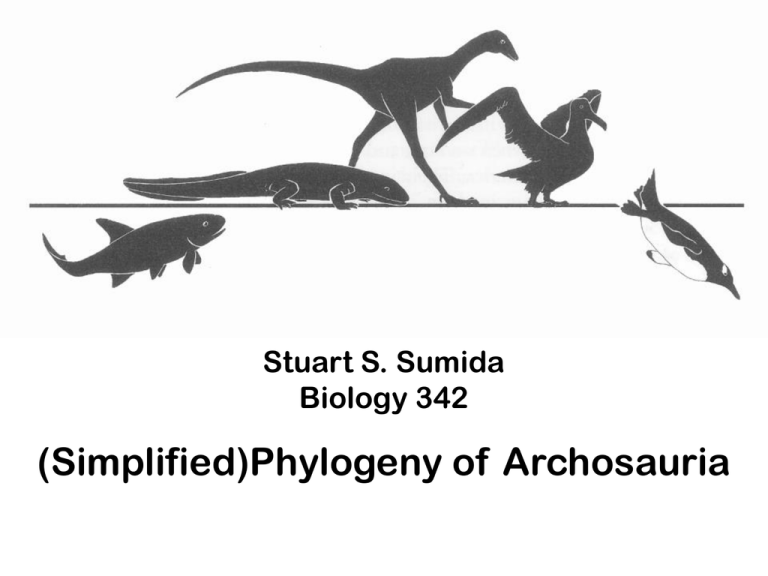
Stuart S. Sumida Biology 342 (Simplified)Phylogeny of Archosauria Remember, we’re studying AMNIOTES. Defined by: EMBRYOLOGICAL FEATURES: amnion, chorion, allantois, yolk sac. ANATOMICAL FEATURES: lack of an intertemporal bone. ALSO, FUNCTIONAL FEATURES: •Costal breathing (inhaling using movement of the ribs). •Active exhalation using movement of ribs to push air out. ARCHOSAURIA ARCHOSAURS ARE DIAPSID REPTILES ARCHOSAURIA INCLUDES: •Crocodylomorpha •Pterosauria •Dinosasuria •Aves (Birds) Crocodylomorpha Pterosauria Eoraptor Herrerasauridae Saurischia Ornithischia Archosauria Alligator mississippiensis Note presence of bony “scutes” or osteoderms in skin. Crocodilians are capable of a variety of types of locomotion: swimming; slow-sprawling walk; a moderate speed “high walk;” and even galloping in some young or smaller ones. PTEROSAURIA: Flying Reptiles of the Mesozoic They are the closest relatives of dinosaurs, but they are not actually dinosaurs. They used elongate 4th finger to support a wing. Reconstruction of the pterosaur Eudimorphodon in pronograde, bipedal walking. TERMS FOR POSTURE Pronograde: backbone parallel to ground Orthograde: backbone perpendicular to ground BIPEDAL and QUADRUPEDAL are not postural terms. Pterydactylus Reconstruction of Pteranodon THE MOST PRIMITIVE DINOSAURS Crocodylomorpha Pterosauria Herrerasauridae? Saurischia Ornithischia Dinosauria Archosauria THE MOST PRIMITIVE DINOSAURS Crocodylomorpha Pterosauria Herrerasauridae Saurischia Ornithischia A perforate acetabulum Crocodylomorpha Pterosauria Herrerasauridae? Saurischia Ornithischia Herrerasauridae: Upper Triassic of Argentina 2 – 4.5 meters long. Long, low skull that is as long as the femur. 24 presacral vertebrae; and the vertebrae are relatively shorter than more primitive forms. Herrerasaurus ischigualastensis Skull reconstruction Herrerasaurus ischigualastensis Reconstruction 24 presacral vertebrae; and the vertebrae are relatively shorter than more primitive forms. Herrerasaurus ischigualastensis Dinosaurian groups more derived than Herrerasaurs may be divided into two groups based on hip construction: SAURISCHIAN ORNITHISCHIAN (Note position of pubis.) ORNITHISCHIA Stegosauria Ankylosauria Pachycephalosauria Ceratopsia Ornithopoda Cerapoda Thyreophora Most ornithischians are herbivores. SAURISCHIA Prosauropoda Sauropoda Theropoda Eoraptor Sauropodomorpha Eoraptor lunensis (“Dawn Raptor”) •From the Upper Triassic of Argentina. •Once thought to be amongst the most primitive of dinosaurs. Now considered to be a primitive Saurischian. SAUROPODOMORPHA Upper Triassic through end of Cretaceous Features that define Sauropodomorpha primarily associated with adaptations for herbivory, large size and, later, graviportal locomotion: •Relatively small head •At least ten vertebrae in very long neck. •Teeth coarsely serrated. •Enlarged sacrum •Extremely large thumb with enlarged claw. More primitive Sauropods BIPEDAL, Extremely large thumb with enlarged claw. Seismosaurus, a more derived sauropod. THEROPODA •Pronograde bipeds. •Pneumatic (hollow) bones. •Enlarged hand. •Vestigial digits IV and V on hand. •Highly extendable digits I-III on hand. •Compact, elongate, narrow foot – usually missing digit V. Theropod Feet: Note missing V. I IV II III Coelophysis, skull Coelophysis: reconstructed in northern New Mexico Sauropodomorpha THEROPODA Coelophysoidea Saurischia * Theropoda Abelisauridae Spinosauroidea Allosauroidea Tetanurae Compsognathidae Tyrannosauroidea Coelurosauria Ornithomimosauria Oviraptorisauria Maniraptora *Ceratosauria Dromaeosauridae Troodontidae Avialae Daspletosaurus T. rex – Predator or scavenger? Probably both… How fast could T. rex really run? Could it run 25 miles per hour? 40? Taking animal mass and the strength of both bone and soft tissue into consideration, T. rex tissues and bones would shatter if moving much over ten miles an hour… For T. rex to be able to travel at 20 m.p.h. the amount of leg muscle mass required to generate that much force would be about 95% to 110% its total body mass. Clearly impossible. If legs are allowed to account for 40-50% of body mass (very generous), a conservative estimate for “cruising speed” is 11 miles per hour. Sauropodomorpha THEROPODA (?)Eoraptor (?)Herresauridae Coelophysoidea Saurischia Abelisauridae Theropoda Spinosauroidea(?) Allosauroidea Tetanurae Compsognathidae Tyrannosauroidea Coelurosauria Ornithomimosauria Oviraptorisauria Maniraptora Dromaeosauridae Troodontidae Avialae AVIALAE: TRUE BIRDS Archaeopteryx lithographica

